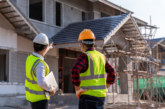Chris Stanley, Housing Manager, Modern Masonry, argues that Modern Methods of Construction (MMC) is not a rapid solution to the housing shortage.
Last month, I attended UK Construction Week where the focus was very much on the latest in modern methods of construction (MMC), from lightweight steel frames to homogeneous containers which stacked like blocks. On the panels, professionals and policy makers were heartily banging the MMC drum.
There’s no ambiguity about the fact the UK is in the grips of a housing crisis and the need for increasing the number of new starts is pressing. We all remember two years ago when the then Chancellor of the Exchequer, Philip Hammond, announced new targets. Admitting there would not be one magic bullet to solve the problem, his words implied everyone across the housebuilding sector would have to pull together.
As such, you would have thought the approach would be to inspire hearts and minds across the whole construction industry, yet the government’s strategy suggests otherwise. At present there is a concerted push for one type of construction in favour of others, namely off-site.
Market slowdown
All this is set against the slowing backdrop of an 8% decrease in new starts, making the proposed 300,000 per annum target by 2025 seem out of reach. So, the blame game begins, with the UK government very much in the firing line. Perhaps to solve this problem, policymakers need to think more holistically and inclusively, taking the harder but more sustainable route than short-term one.
While off-site is among the range of systems we have at our disposal, it is not the definitive answer to current problems. In my view it’s inefficient and misguided to suggest that we put all our eggs in one basket.
There are some short-term benefits to building modular homes, which is why the government has backed it as a construction method. It can reduce labour requirements and limit on-site activities, but investing in offsite manufacturing is still at an early stage and capital costs are very high. On the other hand, the current contractor base is relatively small, meaning developers are unable to negotiate good prices.
Masonry construction
To offer some context, by comparison, around 70% of new build housing is currently achieved with masonry construction. The sector as it stands, is more than capable of absorbing 100% of the current shortfall (80,000). Furthermore, masonry is not at high risk with regards to Brexit, as most of the constituent materials are sourced and manufactured within the UK.
We have a tendency to believe that progress is linear and to assume that things are better simply for the fact of being new. This is just one of a whole host of misconceptions which urgently need to be overturned. After all, masonry has been the primary building material for the majority of our houses for centuries.
The speed at which we need to build requires traditional on-site methods to keep up with demand as well as making use of the years of accrued skills with materials readily and locally available. A full-scale offsite roll-out could be anything from three to ten years away, and we certainly cannot rely on this to solve the immediate housing crisis.
The housebuilding sector is and should be diverse, and there should be room for both on-site and off-site to receive funding to create a level of parity. As with any complex problem, there is no easy fix.









